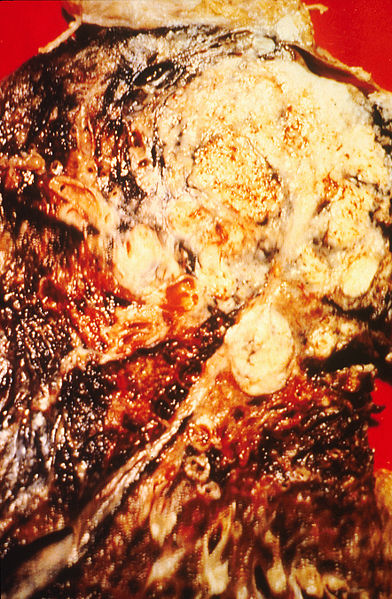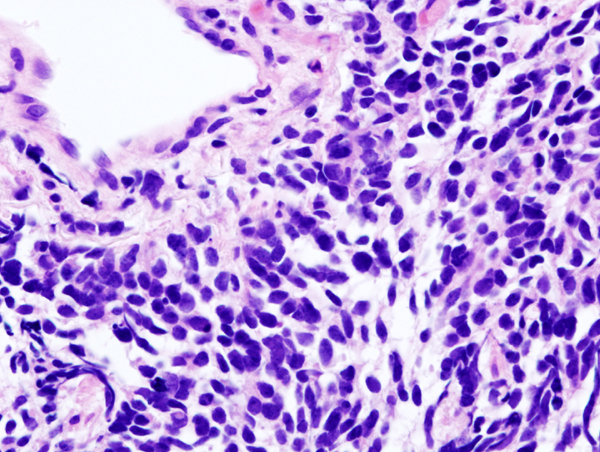Lung cancer pathophysiology
|
Lung cancer Microchapters |
|
Diagnosis |
|---|
|
Treatment |
|
Case Studies |
|
Lung cancer pathophysiology On the Web |
|
American Roentgen Ray Society Images of Lung cancer pathophysiology |
|
Risk calculators and risk factors for Lung cancer pathophysiology |
Editor-In-Chief: C. Michael Gibson, M.S., M.D. [1]; Associate Editor(s)-In-Chief: Kim-Son H. Nguyen, M.D., M.P.A., Beth Israel Deaconess Medical Center, Harvard Medical School, Boston MA, Cafer Zorkun, M.D., Ph.D. [2]; Assistant Editor(s)-In-Chief: Michael Maddaleni, B.S.
Overview
The pathophysiology of lung cancer includes both genetic and environmental factors. Genetic mutations, namely mutations in K-ras oncogene and TP53 tumor-suppressor gene, are associated with the development of lung cancers. Environmental factors often include smoking (most important carcinogen), radon, asbestos, viral infections, and states of chronic lung inflammation, all of which may predispose to cellular damage and DNA mutations that predispose to the development of lung cancers.
Pathophysiology
Genetics
- Lung cancer is initiated by activation of oncogenes or inactivation of tumor suppressor genes.[1]
- Mutations in the K-ras proto-oncogene are responsible for 20% to 30% of non-small cell lung cancer cases.[2]
- Chromosomal damage may also result in loss of heterozygosity, which subsequently leads to the inactivation of tumor suppressor genes. Damage to chromosomes 3p, 5q, 13q and 17p are particularly common in small cell lung carcinoma.
- The TP53 tumor suppressor gene, located in chromosome 17p, is often mutated in lung cancers.[3]
- Several genetic polymorphisms are associated with lung cancer. These include polymorphisms in genes coding for interleukin-1,[4] cytochrome P450,[5] apoptosis promoters such as caspase-8,[6] and DNA repair molecules such as XRCC1.[7] Individuals with these polymorphisms are thought to be more likely to develop lung cancer following exposure to carcinogens.
Environment
Although genetics play a significant role in the pathogenesis of lung cancer, it is thought that exposure to environmental risk factors plays an equally improtant role in the development of lung cancer. The main causes of lung cancer include carcinogens (such as those present in tobacco smoke), ionizing radiation, and viral infections. Chronic exposure results in cumulative alterations to the DNA in the tissue lining the bronchi of the lungs (the bronchial epithelium). Irreversible DNA changes following exposure to carcinogens are directly associated with the development of lung cancer.
Smoking
- Cigarette smoke contains over 60 known carcinogens[8] including radioisotopes from the radon decay sequence, nitrosamine, and benzopyrene.
- Nicotine is thought to reduce the immune response to malignant growths in exposed tissue. The length of time an individual smokes, as well as the amount, significantly increases the person's chance of developing lung cancer.
- Among individuals who stopped smoking, the risk of lung cancer steadily decreases as lung tissue repairs itself and as contaminant particles are eliminated from the lungs. Nonetheless, it is thought that the risk of lung cancer among ever-smokers (even when stopped) is always higher than those who never smoked.[9][10]
- Passive smoking, the inhalation of smoke from another's smoking, is also a risk factor of lung cancer among non-smokers.[11][12][13][14]
Radon gas
- Radon is a colorless and odorless gas generated by the breakdown of radioactive radium (decay product of uranium) found in the earth's crust. The radiation decay products ionize genetic material, causing mutations that sometimes turn cancerous.
- Radon exposure is the second major cause of lung cancer following smoking.[15]
- The mechanism of lung damage following radon exposure is not thought to be due to the radon gas itself, but due to the short-lived alpha decay products that cause cellular damage and DNA mutations.[16]
Asbestos
- Asbestos exposure is associated with many lung diseases, including lung cancer.
- Tiny asbestos fibers are released into the air are breathed into the lungs. The fibers become lodged in the lungs and are stuck for an indefinite amount of time. They can eventually lead to scarring and inflammation.
Viruses
- Viruses are known to be associated with the development of lung cancer in animals and humans.[17][18]
- Viruses include human papillomavirus,[19] JC virus,[20]simian virus 40 (SV40), BK virus, and cytomegalovirus.[21]
- These viruses may affect the cell cycle and inhibit apoptosis, allowing uncontrolled cell division.
- HIV has also been thought to increase the risk of developing lung cancer. Although the mechanism is unknown, HIV is thought to be associated with a state of chronic lung inflammation that may potentiate cellular damage and DNA mutations.[22]
Infection and Inflammation
- There may be a correlation between general inflammation of lung tissue and the development of lung cancers.
- Neutrophils are released in response to bacterial infection and are considered to be the initial responders during inflammation.
- The hypothesis is that neutrophils may activate reactive oxygen or nitrogen species, which can bind to DNA and lead to genomic alterations. Accordingly, inflammation may be thought of as an initiator or promoter of lung cancer development. Also, tissue repair from inflammation is associated with cellular proliferation. During cellular proliferation there may be errors in chromosomal replication that can cause further DNA mutation.
- Angiogenesis, a significant process during tumor growth, may be promoted by chronic states of inflammation, which often require increased blood flow to sites of inflammation.[22]
Gross Pathology

Microscopic Pathology

References
- ↑ Fong, KM (Oct 2003). "Lung cancer. 9: Molecular biology of lung cancer: clinical implications". Thorax. BMJ Publishing Group Ltd. 58 (10): 892–900. PMID 14514947. Unknown parameter
|coauthors=ignored (help) - ↑ Aviel-Ronen, S (Jul 2006). "K-ras mutations in non-small-cell lung carcinoma: a review". Clinical Lung Cancer. Cancer Information Group. 8 (1): 30–38. PMID 16870043. Unknown parameter
|coauthors=ignored (help) - ↑ Devereux, TR (Mar 1996). "Molecular mechanisms of lung cancer. Interaction of environmental and genetic factors". Chest. American College of Chest Physicians. 109 (Suppl. 3): 14S–19S. PMID 8598134. Retrieved 2007-08-11. Unknown parameter
|coauthors=ignored (help) - ↑ Engels, EA (Jul 2007). "Systematic evaluation of genetic variants in the inflammation pathway and risk of lung cancer". Cancer Research. American Association for Cancer Research. 67 (13): 6520–6527. PMID 17596594. Unknown parameter
|coauthors=ignored (help) - ↑ Wenzlaff, AS (Dec 2005). "CYP1A1 and CYP1B1 polymorphisms and risk of lung cancer among never smokers: a population-based study". Carcinogenesis. Oxford University Press. 26 (12): 2207–2212. PMID 16051642. Unknown parameter
|coauthors=ignored (help) - ↑ Son, JW (Sep 2006). "Polymorphisms in the caspase-8 gene and the risk of lung cancer". Cancer Genetics and Cytogenetics. 169 (2): 121–127. PMID 16938569. Unknown parameter
|coauthors=ignored (help) - ↑ Yin, J (May 2007). "The DNA repair gene XRCC1 and genetic susceptibility of lung cancer in a northeastern Chinese population". Lung Cancer. 56 (2): 153–160. PMID 17316890. Unknown parameter
|coauthors=ignored (help) - ↑ Hecht, S (Oct 2003). "Tobacco carcinogens, their biomarkers and tobacco-induced cancer". Nature Reviews. Cancer. Nature Publishing Group. 3 (10): 733–744. doi:10.1038/nrc1190. PMID 14570033. Retrieved 2007-08-10.
- ↑ Peto R, R (2006). Mortality from smoking in developed countries 1950–2000: Indirect estimates from National Vital Statistics. Oxford University Press. ISBN 0-19-262535-7. Retrieved 2007-08-10. Unknown parameter
|coauthors=ignored (help) - ↑ Nordquist, LT (Aug 2004). "Improved survival in never-smokers vs current smokers with primary adenocarcinoma of the lung". Chest. American College of Chest Physicians. 126 (2): 347–351. PMID 15302716. Retrieved 2007-08-10. Unknown parameter
|coauthors=ignored (help) - ↑ CDC (Dec 1986). "1986 Surgeon General's report: the health consequences of involuntary smoking". CDC. PMID 3097495. Retrieved 2007-08-10.
* National Research Council (1986). Environmental tobacco smoke: measuring exposures and assessing health effects. National Academy Press. ISBN 0-309-07456-8.
* Template:Cite paper
* California Environmental Protection Agency (1997). "Health effects of exposure to environmental tobacco smoke". Tobacco Control. 6 (4): 346–353. PMID 9583639. Retrieved 2007-08-10.
* CDC (Dec 2001). "State-specific prevalence of current cigarette smoking among adults, and policies and attitudes about secondhand smoke—United States, 2000". Morbidity and Mortality Weekly Report. CDC. 50 (49): 1101–1106. PMID 11794619. Retrieved 2007-08-10.
* Alberg, AJ (Jan 2003). "Epidemiology of lung cancer". Chest. American College of Chest Physicians. 123 (S1): 21S–49S. PMID 12527563. Retrieved 2007-08-10. Unknown parameter|coauthors=ignored (help) - ↑ Boffetta, P (Oct 1998). "Multicenter case-control study of exposure to environmental tobacco smoke and lung cancer in Europe". Journal of the National Cancer Institute. Oxford University Press. 90 (19): 1440–1450. PMID 9776409. Retrieved 2007-08-10. Unknown parameter
|coauthors=ignored (help) - ↑ "Report of the Scientific Committee on Tobacco and Health". Department of Health. Mar 1998. Retrieved 2007-07-09.
* Hackshaw, AK (Jun 1998). "Lung cancer and passive smoking". Statistical Methods in Medical Research. 7 (2): 119–136. PMID 9654638. - ↑ Template:Cite paper
- ↑ Catelinois, O (May 2006). "Lung Cancer Attributable to Indoor Radon Exposure in France: Impact of the Risk Models and Uncertainty Analysis". Environmental Health Perspectives. National Institute of Environmental Health Science. 114 (9): 1361–1366. doi:10.1289/ehp.9070. PMID 16966089. Retrieved 2007-08-10. Unknown parameter
|coauthors=ignored (help) - ↑ University of Minnesota.http://enhs.umn.edu/hazards/hazardssite/radon/radonmolaction.html#Anchor-Molecular-23240/
- ↑ Leroux, C (Mar–Apr 2007). "Jaagsiekte Sheep Retrovirus (JSRV): from virus to lung cancer in sheep". Veterinary Research. 38 (2): 211–228. PMID 17257570. Unknown parameter
|coauthors=ignored (help) - ↑ Palmarini, M (November 2001). "Retrovirus-induced ovine pulmonary adenocarcinoma, an animal model for lung cancer". Journal of the National Cancer Institute. Oxford University Press. 93 (21): 1603–1614. PMID 11698564. Retrieved 2007-08-11. Unknown parameter
|coauthors=ignored (help) - ↑ Cheng, YW (Apr 2001). "The association of human papillomavirus 16/18 infection with lung cancer among nonsmoking Taiwanese women". Cancer Research. American Association for Cancer Research. 61 (7): 2799–2803. PMID 11306446. Retrieved 2007-08-11. Unknown parameter
|coauthors=ignored (help) - ↑ Zheng, H (May 2007). "Oncogenic role of JC virus in lung cancer". Journal of Pathology. 212 (3): 306–315. PMID 17534844. Unknown parameter
|coauthors=ignored (help) - ↑ Giuliani, L (Sep 2007). "Detection of oncogenic viruses (SV40, BKV, JCV, HCMV, HPV) and p53 codon 72 polymorphism in lung carcinoma". Lung Cancer. 57 (3): 273–281. PMID 17400331. Unknown parameter
|coauthors=ignored (help) - ↑ 22.0 22.1 Eric A Engels.11/30/11. Inflammation in the development of lung cancer:epidemiological evidence.Expert Review of Anticancer Therapy.Apr.2008.p605